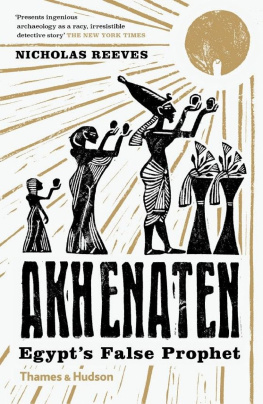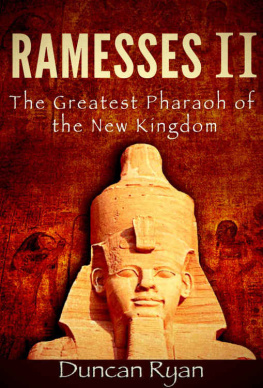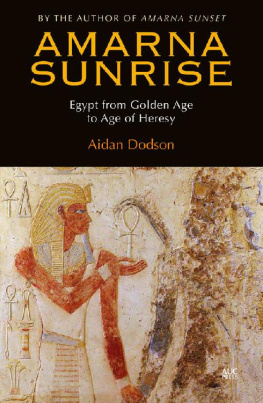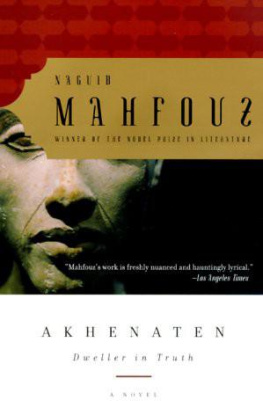My mother, Marion Kozloff, introduced me to Egyptian art on visits to the University of Pennsylvania Museum. Elizabeth Finkenstaedt introduced me to Amenhotep III at Mount Holyoke College. John D. Cooney encouraged me first to look more closely at the monuments of Amenhotep III and then to step back and view the oeuvre as a whole. This has been a long journey, and these three, all true of voice and repeating life, are just the first of countless individuals to be thanked, only a few of whom can be mentioned here.
In 1992, Betsy Bryan and I, after twenty years of dreaming and ten years of planning, were joined by Larry Berman and lisabeth Delange and produced the exhibition Egypt's Dazzling Sun/ Le Pharaon Soleil , which was devoted to a better understanding of Amenhotep III's monuments. The book presented here is aimed more at the man himself, his life, and the issues confronting his reign, but I owe these three colleagues a great debt of gratitude.
Edmund S. Meltzer patiently read many drafts of this work and contributed innumerable bits of information and advice. His generous collegiality, wisdom, and erudition are remarkable, and his encouragement was a constant touchstone. Susan Giuffre read an early draft and Richard Wilkinson a later one, the latter sending me to Beatrice Rehl of Cambridge University Press, who was welcoming and patient. Virginia Krumholz read the penultimate draft and suggested areas needing expansion. Lisa Haney checked the bibliography, as did Dr. Meltzer. Ken Karpinski, Eleanor Umali, and James Dunn oversaw production.
Before any writing could occur, years of haunting libraries, museums, and, of course, Egypt, were necessary. On visits to Egypt, Head of the Supreme Council, then Minister of Antiquities, Dr. Zahi Hawass, and his assistant, Janice Kamrin, smoothed my way, gave me tremendous encouragement, and provided photographs or photographic permission. Former Chief Inspector Sayed Hegazy aided my travels in many practical ways, in addition to offering insights unknown to most foreigners. Egyptian Museum registrar Yasmin El Shazly and Supreme Council assistant Beth Asbury were also extremely helpful.
The staff members of the British Museum's Department of Ancient Egypt and Sudan were endlessly hospitable and generous with their time, space, resources, and thoughts, especially W. Vivian Davies, the head of the department; Susanne Woodhouse, librarian; and Richard Parkinson, John Taylor, Derek Welsby, Marcel Mare, and the rest of the curatorial and administrative staff. Over the years, the staffs of the Cleveland Public Library's Special Collections, especially the White Collection, and of the library of the Cleveland Museum of Art have also been extremely helpful and kind.
The American Research Center in Egypt has provided a platform for me to forward almost all the new ideas presented here, and I have benefited tremendously from the discussions generated. Undoubtedly, some colleagues will be disappointed that they did not change my mind, whereas others will be happy that they did.
In addition to those named earlier, I am endlessly grateful to the scholars and scientists who have discussed at length various points with me or have guided me through their excavations or museum collections, for example, Hourig Sourouzian, Peter Lacovara, Salima Ikram, Charles Van Siclen, Rita Freed, Angus Graham, Tom Hardwick, James Harrell, Martina Ullmann, David OConnor, Helen Jacquet, Dorothea Arnold, Earl Ertman, Marianne Eaton-Krauss, Ray Johnson, Andrew Gordon, May Trad, Rene Dreyfus, Melinda Hartwig, William Peck, Gay Robins, Karola Zibelius-Chen, Regine Schulz, Christine Green, and Richard Fazzini. In addition, Ian Shaw, Maarten Raven, Lawrence Berman, Jiro Kondo, Louise Chu, Luc Limme, and Richard Wilkinson generously contributed photographs. Eric Gubel, Klaus Finneiser, Catharine Roehrig, Guillemette Andreu, Gabriele Pieke, and Claire Derriks also assisted (in addition to those cited in the captions) in obtaining photos and/or permissions.
Many outside of Egyptology answered questions or gave advice, for example, on the subjects of bubonic plague in Egyptian antiquity and ancient diseases in general, Drs. Joe Hinnebusch and Kent L. Gage (National Institutes of Health, Rocky Mountain Labs), Dr. Tom Schwan (Centers for Disease Control), and Dr. Eva Panagiotokopulu (University of Sheffield); and on the subjects of horse training and chariotry, Dariush Elghanayan and Rich Petersen. Medievalist Sara Jane Pearman and classical archaeologists Mary Ellen Soles and Sandra Knudsen gave excellent counsel.








